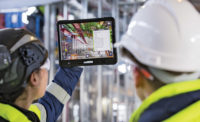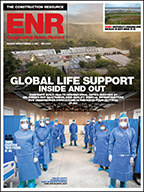The latest version of the '3D modeling for everyone' application SketchUp was demonstrated at the Trimble Dimensions conference held in Las Vegas November 3 to 5. In addition to a few notable improvements under the hood, the latest version of the popular 3D design tool is compatible with Trimble Connect, Trimble's cloud-based platform which can share design files across a range of Trimble applications.
"The association with Trimble Connect makes SketchUp an even more profoundly useful tool," says John Bacus, product manager for Trimble SketchUp. "Now we have not just data on models in an interoperability schema that people understand how to use in the industry, but we've also got a space where we can distribute that data—share it with other people, mash it up with others' work, from structural engineers to civil engineers or whoever needs to contribute to the project."
According to Bacus, SketchUp will see uses in construction beyond initial sketching and design with Trimble Connect. "During the construction phase, there are always issues that need resolution. Sketchup can be a tool for solving that one little field condition, reaching consensus on what to do about a particular hanger placement or flashing detail that no one really thought about in a corner of the building."
The 2015 edition of SketchUp features some upgrades to meet these new demands. The application is now capable of 64-bit memory addressing, an update that should improve performance and stability, particularly when loading large, complex files. SketchUp 2015 has several new drawing tools including the ability to draw rotated rectangular polygons to any angle, a much-requested feature according to Bacus. SketchUp also now supports the IFC file format, the platform-neutral standard supported by many BIM software suites. "Now we can ingest and emit data in the IFC format, and I think that's an important interoperability moment for SketchUp," says Bacus.
On the hardware front, SketchUp 2015 is now compatible with Trimble's V10 Imaging Rover, a panoramic jobsite camera. "We have an integration with the V10 in SketchUp now, so you can stand out in the middle of a construction site, hit the button on the V10 camera, grab a panoramic image, process that through the Trimble Business Center application back in the office and create a SketchUp model which contains all of the photographs that were taken with the camera in calibrated positions," says Bacus. "With this SketchUp model you can actually start to explore the space of the photograph."
While Trimble plans to keep the free version of SketchUp available, the company has begun to add trade-specific tools to the SketchUp Pro paid version. MEPdesigner is a SketchUp module announced at Dimensions and is intended for light design work in the MEP trades. "The first generation of this product will be targeted at the electrical trades," says Patrick Bohle, general manager for Trimble's MEP division. MEPdesigner will also work with SketchUp's 3D Warehouse, a free online repository of 3D models created by SketchUp users. "There is significant MEP content already in the Warehouse, including content created by manufacturers," says Bohle. "So you could find the actual lighting element to be used and drop it in to the model, then match it up with the conduit and wiring."
Trimble acquired SketchUp from Google in 2012, bringing the tool back toward its architectural design roots. For Bacus, who has been with SketchUp since the beginning, the tool's main purpose remains unchanged. "We invented SketchUp to be 3D for everyone—to bring modeling and design communication to a broad, broad audience. I think what's changing is that the features that are important to practical professional designers are getting more complex. The design requirements are getting more complex," he says.
"We're building tools for that. But we don't ever want to lose sight of the thing that we founded, the company, which was really the broadest possible democratization of modeling, design, visualization. The figuring out of what it is we're going to build before we build it."




Post a comment to this article
Report Abusive Comment